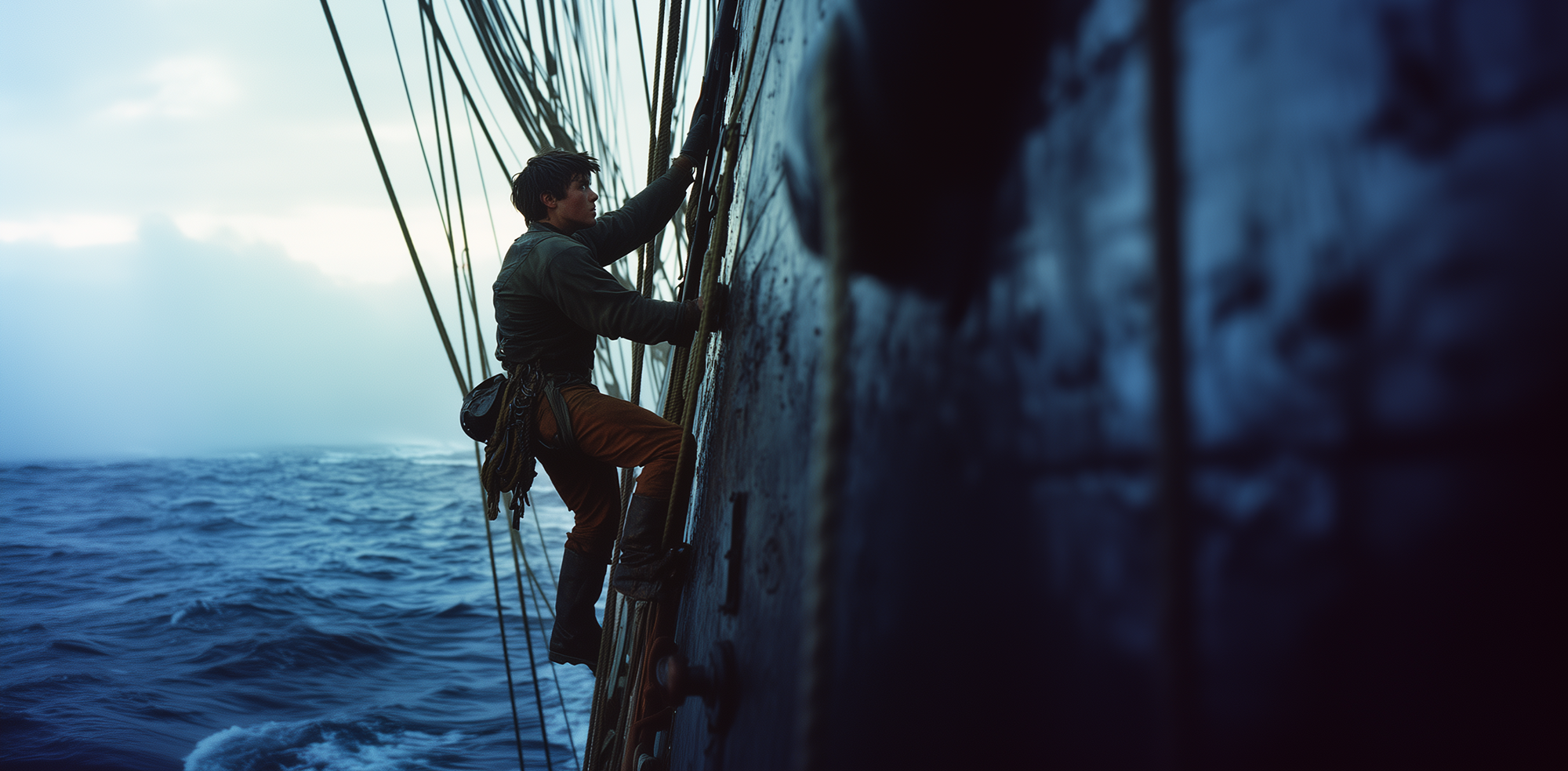Chapter 24: The Cruise of the Coracle
Chapter 24 of Treasure Island sweeps readers into a gripping battle against the sea as Jim Hawkins awakens adrift in the treacherous coracle.
Tossed about by the waves, Jim quickly realizes he is at the mercy of the currents, with the tiny craft pulling him dangerously close to being swept out to sea.
Surrounded by towering capes and cliffs, Jim’s fear grows as he spots strange creatures along the rocky shore—“huge slimy monsters, soft snails, as it were, of incredible bigness,” which he later recognizes as sea lions.
The eerie and desolate scene heightens his sense of isolation, and his futile attempts to paddle only drive him deeper into dread:
“I began to be horribly frightened.”
Through the mist and spray, Jim spies the Hispaniola, her sails flapping idly as she drifts without direction, “dancing on the waves by swoops and dashes.” The sight of the abandoned schooner ignites a flicker of hope. Desperately fighting the waves, Jim struggles to guide the coracle closer to the ship, the danger of capsizing hanging over him with every stroke.
When he finally reaches the Hispaniola, battered and exhausted, the ship looms large and silent—a ghostly presence on the restless sea. Summoning the last of his strength, Jim seizes the moment and leaps aboard the schooner. But is the ship truly abandoned, or does new peril await him onboard?
Chapter 24 brims with suspense as Jim’s daring leap brings him closer to the heart of the adventure—and deeper into the unknown. The sea may be behind him, but the dangers ahead have only just begun.
CREATE YOUR OWN IMAGINATIVE WORLD
Robert Louis Stevenson wrote Treasure Island primarily for his stepson, Lloyd Osbourne, who was around 12 years old at the time. The inspiration struck when Robert and Lloyd were drawing a treasure map together during a holiday in Scotland, sparking Stevenson’s imagination and leading him to create a full story.
He’s not the only one who can invent a world. Now it’s your turn.
TERMS TO KNOW
Beetling crags – steep, overhanging rock formations or cliffs that appear to jut out dramatically. “Beetling” suggests the crags project outward in a way that makes them look threatening.
Slip so quietly through the rollers – moving smoothly and silently over the rolling waves (“rollers”) in a stealthy motion, with the vessel gliding gently and unobtrusively through the water.
Main-sail and two jibs – the main-sail is the largest sail on the mainmast and provides most of the driving power, while the two jibs are smaller triangular sails located at the front of the ship.
“Set them skipping” – dismissed the crew (or certain troublesome individuals) with little tolerance.
“Filled again upon another tack” – a ship adjusting its course by catching the wind in its sails from a different direction.
“She hung each time so long in irons” – the ship is stuck with its bow pointing directly into the wind, causing the sails to lose wind and leaving the ship stalled and unable to move forward.
The water breaker beside the fore companion – a small barrel of fresh drinking water near the front of the ship.
Brass glisten on the tiller – the polished brass fittings on the tiller (the lever used to steer the ship) shining or reflecting light.
Batten them down – to secure the hatches or cover openings on the ship’s deck to prevent water from entering during rough weather or turbulent seas.
Yawing – a ship swerving off its intended course, often in an unsteady or uncontrolled manner.
Leeway – the sideways drift of the ship away from its intended course due to wind or currents.
“The wind came again in a clap” – a sudden, strong gust of wind hitting the ship with force, like a clap.
Port tack – the ship’s sailing position where the wind is coming from the port (left) side of the vessel.
“Stooping and skimming like a swallow” – comparing movement to the graceful, rapid flight of a swallow, known for its agility.
Forefoot – where the keel (the ship’s main bottom structure) meets the stem at the front. It’s located at the base of the bow, forming the forwardmost part of the ship’s underwater structure.
Jib-boom – a spar (a long pole) that extends from the bowsprit, the horizontal pole at the front of a sailing ship. It supports the jib sails, triangular sails rigged in front of the foremast.
Between the stay and the brace – a “stay” is a strong rope that supports the mast, running from the mast to the bow (front) or stern (back) of the ship. A “brace” is a rope used to adjust the angle of the yards (horizontal spars that hold the sails).




